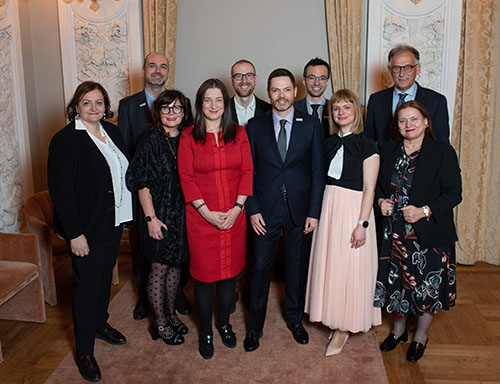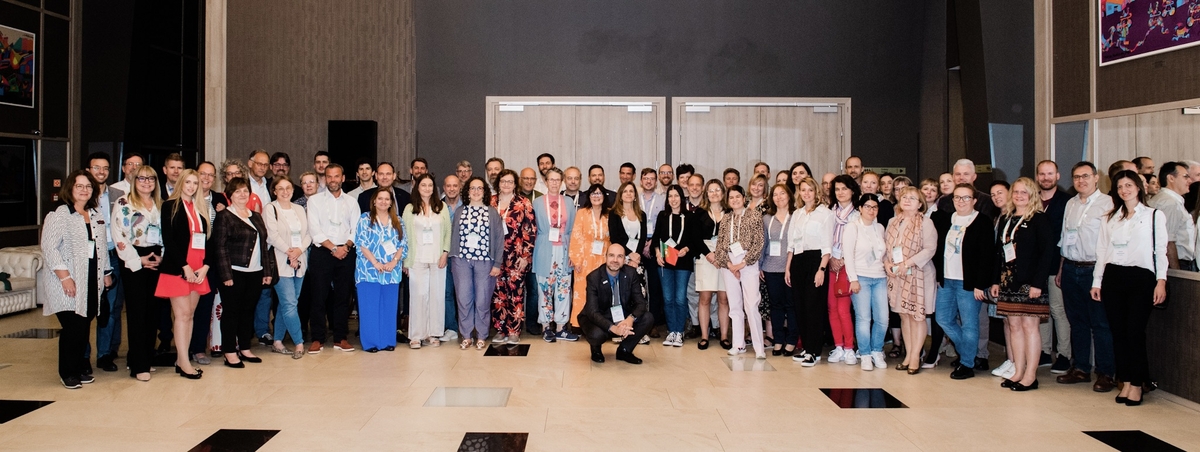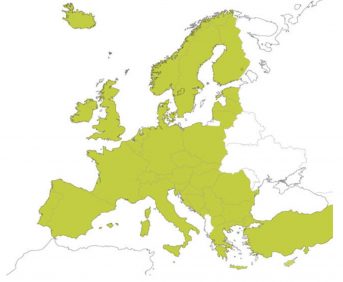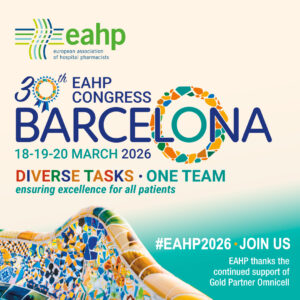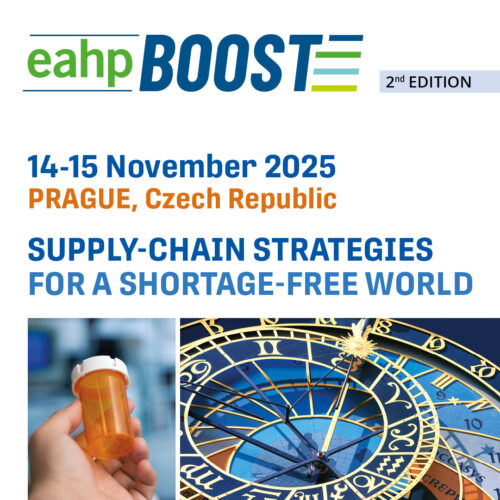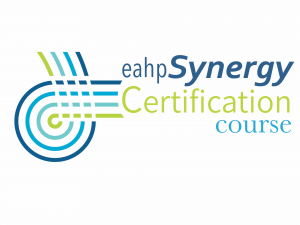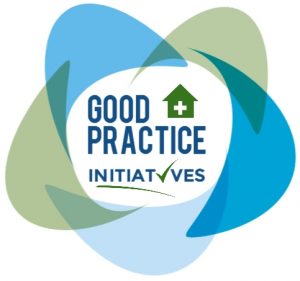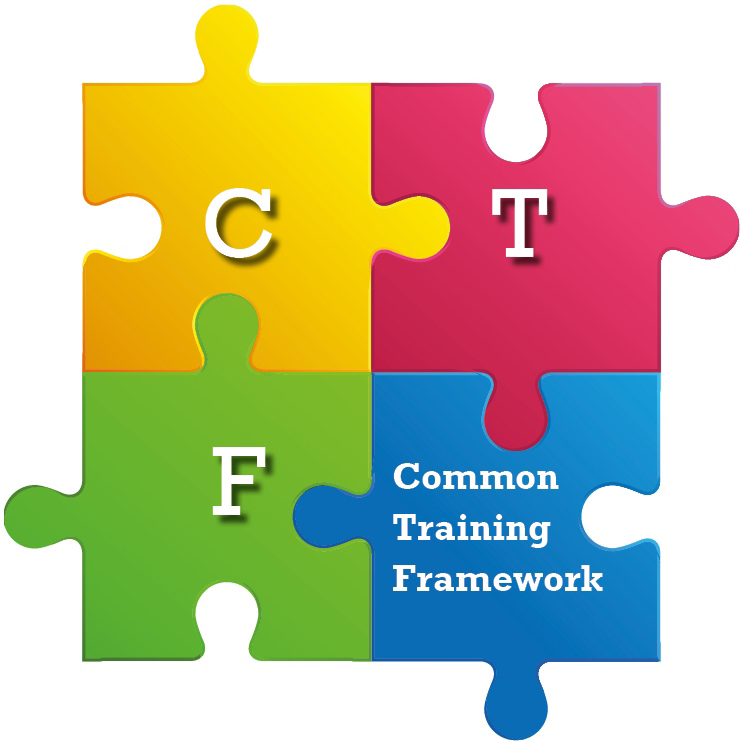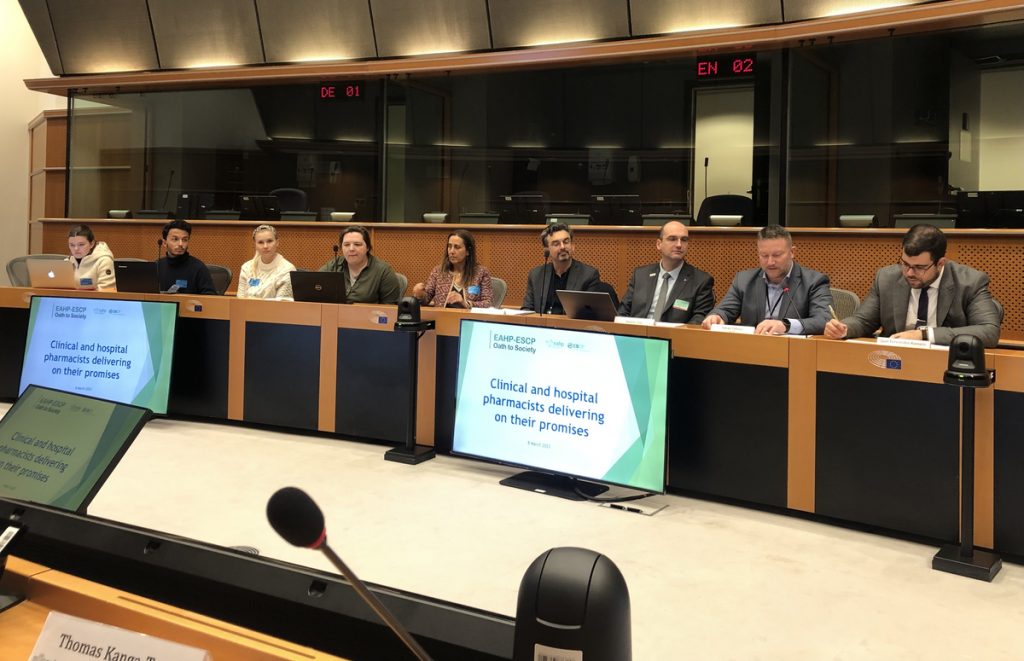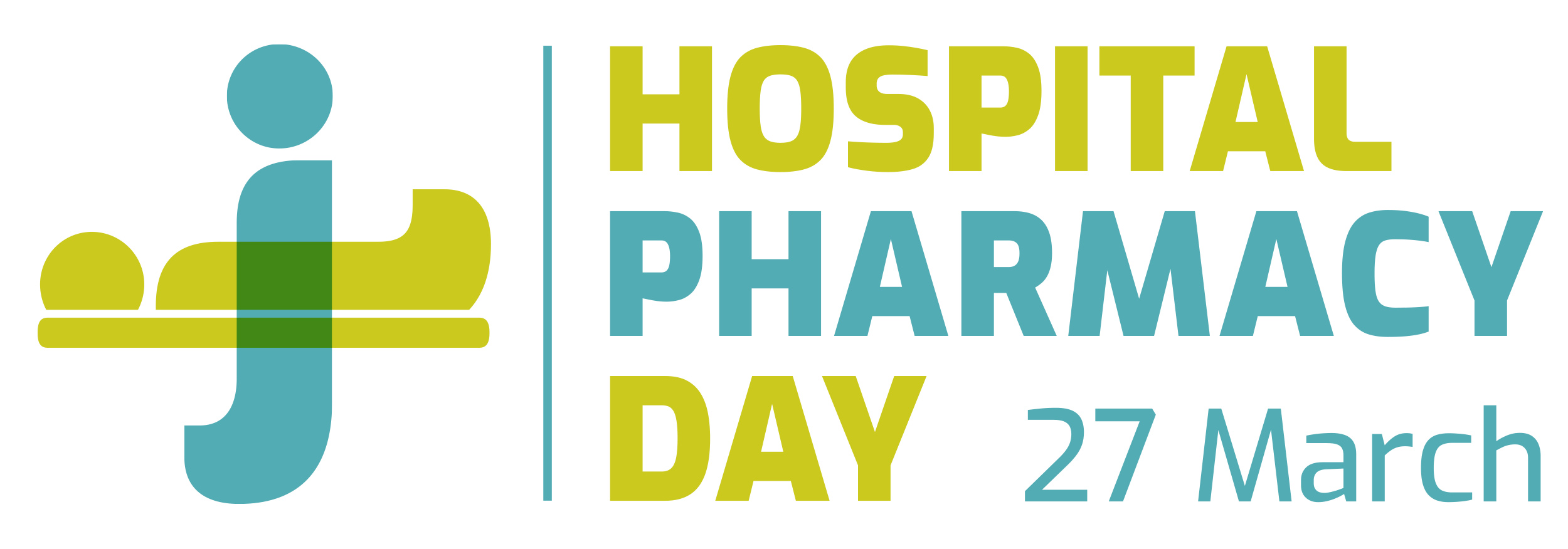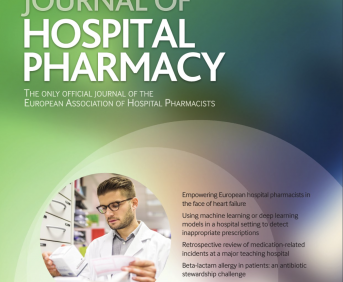PHARMACEUTICAL CARE AND CHARACTERIZATION OF PATIENTS WAITLISTED FOR KIDNEY TRANSPLANTATION IN A THIRD LEVEL HOSPITAL
Pdf

European Statement
Clinical Pharmacy Services
Author(s)
M. López López-Cepero, H. Padilla Castaño, G. Arrufat Goterris, P. Clares Rubio, T. Bonnin Garau, A. Tugores Vázquez, C. Martorell Puigserver.
Why was it done?
A pharmaceutical care consultation (PCC) was implemented for patients waitlisted for kidney transplantation (PWKT). The PCC focuses on transplant medication education, accurate medication history, allergy review, adherence assessment and self-perception of therapeutic complexity.
What was done?
Medication non-adherence is the major issue in transplantation, and it is associated with increased risk rejection, allograft loss and patients’ death.
Medication education after the transplant was not enough. Intervening before the transplant enabled pharmacists to know the patients and develop an individualized therapeutic plan, so the patients arrive as prepared as possible on the day of the transplant.
How was it done?
PWKT were scheduled in PCC and the pharmacist review their medical history and prescriptions. Patients were contacted by telephone for an interview. A face-to-face consultation was also possible.
PCC evaluate:
1) Clinical variables: etiology of renal pathology, comorbidities, previous transplantation, current renal replacement therapy (TRR), CYP3A5 genotype.
2) Medication: allergies, current medication plan, adherence (Morisky-Green test and electronic prescription record), organization and self-perception complexity.
3) Pharmaceutical interventions (PI): deprescribe or update current treatment, reinforce adherence, propose Monitored Dosage System (MDS) or pillbox, immunosuppressants education, arrange for a second PCC, contact with their community pharmacy, send to Pharmacogenetics Committee.
What has been achieved?
The PCC was implemented in June 2024. Among the first 4 months, 28 of the 58 PWKT have been evaluated.
Analyzing the clinical variables has allowed us to describe PWKT profile. Knowing how patients manage medication, as well as the perception they have about the importance of their treatment, helps to create an action plan and better prepare the patient for the transplant.
Given that one third of the patients were non-adherent, most of the PI focused on adherence reinforce, including additional monitoring, propose MDS or pillbox pillbox and resolve medication doubts.
What next?
The next step is to include a PCC in our clinical practice and get to visit all PWKT before the transplant.
It is needed to evaluate the impacts of PCC and PI as regards clinical outcomes. Detecting improvement actions will be enriching for patients care.
The PCC can be extended to other types of solid organ transplants.
MONITORING OF PRESCRIPTIONS FOR VOLUNTARY INTERRUPTION OF PREGNANCY AND SPONTANEOUS ABORTION WITHIN THE FIRST TRIMESTER OF PREGNANCY
Pdf

European Statement
Clinical Pharmacy Services
Author(s)
V. Mureddu, G. Ledda, G. Adamu, M. Rivano, A. Cadeddu. Hospital Pharmacy Department, Azienda Ospedaliero Universitaria, Cagliari.
Why was it done?
Mifepristone and misoprostol are provided for Voluntary Pregnancy Interruption (VPI) and Spontaneous Miscarriage (SM) according to different reimbursement schemes, based on different gestational age. According to Summary of Product Characteristics (SPC), the use of mifepristone and misoprostol is approved only within the first 63 days of pregnancy. Recently, access to treatment for VPI and SM has been extended by the Italian Medicines Agency by the I trimester of pregnancy. VPI within the first 49 days of gestation, the use of mifepristone and misoprostol is authorized according to SPCs. From 50th to 63th days is guaranteed under the law 649/96, that allows and reimburses the use of medicines for off-label indications. From 63th to 90th is considered an off-label prescription. Regarding SM, mifepristone and misoprostol can be used within the I trimester under the law 648/96. All these different reimbursement schemes are used as part of the Italian pricing-reimbursement system.
What was done?
To ensure appropriateness, a specific prescription form has been drafted to support clinicians in prescribing according to the correct reimbursement scheme gestational age, therapeutic indication and dosage must be reported in the prescription form.
How was it done?
The development of the prescription form required a deep knowledge of both the law under which the right of abortion is guaranteed and Italian reimbursement schemes. The prescription form was introduced in October 2022.
Prescriptions of all pharmacological treatments are ordinarily made through electronic software; therefore the prescription form was uploaded. Prescriptions from 01/01/2024 to 30/06/2024 were collected and retrospectively analyzed.
What has been achieved?
Prescription forms analysis showed that a total of 83 women were treated. In 53 cases the treatment was used for VPI and in 30 for SM. In 27% of cases, prescriptions were considered as per in-label. In 66% cases, prescriptions were allowed according to Law 648/96. In 7% of cases, prescriptions were off-label.
What next?
According to the development of reimbursement schemes, the prescription form will be implemented. Italy provides universal coverage for all citizens and residents; keeping it sustainable is one of the hardest challenges of these day. The contribution of hospital pharmacists in monitoring prescriptions has a pivotal role in making equal access to these treatments.
CHEMOTHERAPY MEETS HERBAL MEDICINE: NAVIGATING THE INTERACTION MAZE IN THORACIC ONCOLOGY
Pdf

European Statement
Clinical Pharmacy Services
Author(s)
Margot DESCHAMPS, Nejib BORGAAOUI, Jimmy ROSE, Jennifer LE GRAND, Louise NICOLAS
Why was it done?
One of the clinical pharmacy activities in the thoracic oncology department is the analysis the interactions between chemotherapy and Complementary and Alternative Medicine (CAM). Cancer patients often seek alternative treatments which requires a rigorous evaluation of potential interactions. The goal of this study is to assess the methods used to analyze these interactions.
What was done?
To ensure traceability of the analysis, a tracking table for requests was created. The requests, coming from doctors, nurses, or patients, are recorded with key information such as name, date of birth, and the purpose of the analysis. Five information sources were selected, including the Herbal Medicine section of MedlinePlus, the website of the Memorial Sloan Kettering Cancer Center (MSKCC), a database of plants and dietary supplements published by the French National Agency for Food, Environmental and Occupational Health Safety, a database from the European Scientific Cooperative on Phytotherapy, and a publication from the journal Medical Oncology (Vol 36, number 45, 2019).
How was it done?
In nine months, 25 interaction requests were processed, 70% of which were from doctors. The analysis took an average of 30 minutes and were completed within 24 to 48 hours. The interactions mainly concerned oral chemotherapies (n=18), particularly Osimertinib (n=13). The requests involved various CAM (essential oils, medicinal plants, dietary supplements), with an average of four products per request. Desmodium was the most frequently analyzed product (n=5). In total, for 24 CAM, including Desmodium, was not recommended for use after analysis due the drug interaction risk and modification of liver metabolism of chemotherapies.
What has been achieved?
It is difficult to prohibit CAM to patients, and most substances can be taken at recommended doses. However, determining the precise dosage at which an interaction with chemotherapy occurs is complex due to the lack of a single reference. Using various sources allows for cross-referencing expertise and obtaining complementary information. For instance, MedlinePlus offers a generalist approach, while MSKCC focuses on interactions in oncology. Using international sources broadens the analysis and fills geographical or cultural gaps.
What next?
For the future, we would like to develop a tool that compiles the five data sources in order to be exhaustive in our future analysis.
A state-of-the-art on medical devices in Italian clinical pharmacy practice: results from the Italian Society of Clinical Pharmacy and Therapeutics (SIFaCT) survey
European Statement
Clinical Pharmacy Services
Author(s)
Lorenzo Di Spazio, Daniele Mengato, Andrea Ossato, Vera Damuzzo, Marco Chiumente, Giulia Dusi, Sabrina Trippoli, Andrea Messori, Maria Cecilia Giron, Maria Chiara Silvani, Francesca Venturini
Why was it done?
Pharmacist’s activities on MDs are mainly linked to governance, management and vigilance but little to clinical pharmacy practice. In order to study and develop interventions aimed at optimizing the use and compliance of medical devices on patients, a national survey was conducted to identify the clinical pharmacy experiences already consolidated in this field.
What was done?
Clinical pharmacy activities that demand specialized expertise in medical devices (MD) constitute a relatively uncharted territory for hospital pharmacists. Our aim, through a nationwide survey, was to delineate the clinical responsibilities overseen and handled by hospital pharmacists that necessitate a specific focus on MDs.
How was it done?
A 54-question survey, available from 1 October 2022 to 31 December 2022, was created by a pool of experts from an Italian scientific society (Italian Society of Clinical Pharmacy and Therapeutics – SIFaCT) and shared through Google Forms. The questions, divided into six sections, were related to five clinical areas defined by the working group: surgery room (SR), wound care (WC), vascular access management (VAM), patient education on diabetes treatment technologies (DTT) and MD in oncology and artificial nutrition (ON).
The questionnaire allowed us to define the state-of-the-art of clinical pharmacy on MDs, highlighting the activities and training needs of the participants.
What has been achieved?
We received 142 responses. In particular, emerged that 42% of participants adopted standard kits in the SR and 76% of them declared the pharmacist involvement.
A specific team for WC was created for 35% of participants, with the involvement of the pharmacist in 90% of cases, in particular as consultant role in 22%.
37% of participants declared the presence of a team dedicated to VAM, with the involvement of the pharmacist in 40% of cases and patient counselling in 9%. Finally, in DTT and ON the pharmacist was involved in 8% and 10% of the responses, respectively.
What next?
This first national survey shows that the pharmacist is often involved in multidisciplinary groups in the five analyzed areas, but less involved in patient’s counselling probably due to the sub-optimal training in the field of MDs. Indeed, almost all the participants declared the need to improve their knowledge in this field and create a network among colleagues.
Enhance prescription review: artificial intelligence to improve efficiency and safety drug therapies
European Statement
Clinical Pharmacy Services
Author(s)
Ana Helena Ulbrich, Amanda Fonseca, Catherine Isoppo, Henrique Dias
Why was it done?
The motivation behind NoHarm stemmed from the time-consuming nature of the prescription review process, which required clinical pharmacists to assess not only drug interactions but also factors such as appropriateness, effectiveness, safety, adherence, and affordability of drug therapies. NoHarm was envisioned as a solution to systematize the workflow and provide cross-referencing of essential drug and inpatient information, thereby addressing these issues.
What was done?
The NoHarm initiative was developed to address challenges faced by clinical pharmacy teams during the prescription review process in a hospital setting. This open-source intelligent system was introduced to enhance the medication review process. The initiative was executed in a 420-bed public hospital in Brazil over a 17-month period to evaluate its impact on prescription reviews.
How was it done?
The implementation of NoHarm involved integrating the system with the hospital’s electronic health records to collect and compute all inpatient data. NoHarm utilized a drug knowledge base and intelligent algorithms to identify and alert healthcare professionals about inpatient risks. The algorithms were designed to cross-reference patient laboratory results with drug thresholds, adjust for liver and renal function, analyze drug usage patterns at the hospital, and extract patient risk factors from clinical notes, including diseases, adverse events, symptoms, and biometric data.
What has been achieved?
The number of medications assessed increased dramatically from 17,000 to 2,643,957 within the 17-month period, all while maintaining the same team size. Improved prescription review rates, rising from 65% to 94%, demonstrate the effectiveness of the system. Furthermore, these improvements in prescription reviews resulted in better clinical pharmacy services and contributed to reducing medication errors and associated risks in patient care at the hospital.
What next?
NoHarm is an open-source solution and an example of good practice in healthcare due to its achievements in streamlining prescription reviews and enhancing patient safety. Its successful implementation led to increased efficiency, higher prescription review rates, and substantial cost savings, showing its potential as a model for other healthcare settings. Its prospective global applicability makes it a solution to address medication errors and elevate the standard of care in healthcare institutions worldwide.
Pharmacy residents in the intensive care unit: education and training
Pdf

European Statement
Clinical Pharmacy Services
Author(s)
Pilar Lalueza Broto, Laura Domenech Moral, Alba Pau Parra, Ángel Arévalo Bernabé, Danae Anguita Domingo, Anna Rey Pérez, Jacinto Baena Caparrós, Marcelino Baguena Martínez, María Queralt Gorgas Torner, Mónica Rodriguez Carballeira
Why was it done?
The four-year specialist training program for Hospital Pharmacy in Spain includes one year of clinical training, involving rotations through various medical units where residents develop their clinical skills. This forms an essential component of clinical proficiency and integration into the healthcare team.
The Intensive Care Unit (ICU) was chosen because the presence of a pharmacist during rounds as a full member of the care team has been associated with a reduced rate of adverse drug events.
What was done?
We developed a standardized medication audit tool to ensure uniform pharmaceutical care delivery, aligned with the Hospital Pharmacy Specialty training program.
How was it done?
We designed a pharmacotherapeutic monitoring chart containing biodemographic and clinical data, analytical parameters, and clinical issues for each patient. A multidisciplinary team, comprising staff physicians and pharmacy resident tutors, identified the most common clinical problems or key issues for different types of patients admitted to critical care units, as well as specific clinical problems related to particular pathologies. Pharmacotherapeutic recommendations were based on clinical evidence or internal protocols. Common key issues included nutritional support, fluid resuscitation, thromboembolic prophylaxis, hemodynamic monitoring, infection management, drug monitoring, and sedative and analgesic therapy. We defined specific efficacy and safety indicators for each clinical problem. Additionally, we monitored specific outstanding problems in particular patient types.
We also implemented a model for recording and coding pharmaceutical interventions.
What has been achieved?
The pharmacotherapeutic monitoring chart has enabled us to establish standards for pharmaceutical care in the ICU, promoting consistency among the entire care team and optimizing pharmacotherapy outcomes in patients. It also facilitates the assessment of residents’ skill acquisition during their training.
What next?
In the future, assessing the tool’s usefulness and its impact on residents’ training benefits will be of interest. Moreover, it may serve as a reference model for other clinical rotations.
Stratification of psoriasis patients according to pharmaceutical care needed using the capacity-motivation-opportunity pharmaceutical care model
Pdf

European Statement
Clinical Pharmacy Services
Author(s)
NOELIA VICENTE-OLIVEROS, CARMEN PALOMAR FERNANDEZ, TERESA GRAMAGE-CARO, PAULA BURGOS BORDEL, MARÍA DEL CARMEN CALATAYUD SÁNCHEZ, SANDRA CASADO ANGULO, ANA MARTÍN ÁLVARO, MARÍA BEGOÑA RIVERA MARCOS, SONALI KARNANI KHEMLANI, MANUEL VELEZ-DIAZ-PALLARES, ANA ALVAREZ-DIAZ
Why was it done?
Patients with moderate-severe psoriasis require systemic hospital-dispensed treatments. Hospital pharmacists look for actions to anticipate patients’ needs for achieving health outcomes and the system’s sustainability.
What was done?
We stratified psoriasis patients according to the pharmaceutical care needed and established their pharmaceutical care plan. We calculated the time needed in pharmaceutical care after stratification.
How was it done?
An observational, prospective, cross-sectional study was conducted in a university hospital. One hundred psoriasis patients who received medication in the outpatient hospital pharmacy were randomly chosen between March-May 2022.
Capacity-Motivation-Opportunity (CMO) pharmaceutical care model (SEFH, 2018) was used to stratify patients. This model consisted of 23 variables (demographic, clinical, pharmacological, socio-sanitary, cognitive and functional). Each variable scored between 1-4, depending on patient risk. Patients were classified on three levels which determined the subsequent pharmaceutical care to be provided to each patient:
1. global score≥31 points,
2. 18-30 points and
3 ≤17 points.
Information was collected through patients’ interviews and electronic health records review.
A group of nine pharmacists were set up to adapt the CMO pharmaceutical care model to our hospital.
Total time spent in pharmaceutical care was obtained through patient visits before and after stratification. The scheduled average time for each visit was 10 minutes. The number of visits pre-stratification was the sum of all the visits scheduled for the patients, and for post-stratification was the sum of all the visits with the new CMO model (level 1 (biannual), 2 (annual), 3 (as needed).
What has been achieved?
Most patients were stratified on level 3. A pharmaceutical care plan has been designed to meet the needs of each patient.
Stratification has improved the time pharmacists have to accomplish the needs of each patient (16.3 hours/year (98 visits)). Sixty-two percent of patients had as needed visits (level 3), 36% needed annual visits (level 2) and 2% biannual (level 1). However, during pre-stratification, most the patients (70%) had every nine months visits, 18 % every 12 months, 9% every six months and 3% every three months.
What next?
We will expand the stratification to the rest of the psoriasis patients and other outpatient pathologies.
We will coordinate strategies with Social and Psychological Services, Primary care and Community pharmacy to improve pharmaceutical care.
Towards e-documentation of clinical pharmacist interventions
Pdf

European Statement
Clinical Pharmacy Services
Author(s)
Andrea Bor, Nóra Gyimesi, Eszter Erika Nagy
Why was it done?
Intervention-oriented classification systems are helpful tools to document the CPIs in a structured manner. Our aim was to develop a clinical pharmacy platform in the e-documentation system at our institution. This CPI data enables healthcare providers to track medication history, and to systematically analyse the effectiveness and the pharmacoeconomic benefits.
What was done?
A pilot survey was conducted on the traumatology wards to analyse and describe our clinical pharmacist interventions (CPI) based on severity and clinical relevance.
How was it done?
Three clinical pharmacists collected data on the changes of drug therapy at two 31-bed traumatology wards during pre- and postoperative period. We adopted the CPI classification system to our daily practices. This is challenging since the narrow time frame between patient admission and discharge often limits the opportunity to provide clinical pharmacy services. Raw data was previously screened and classified into 5 categories, drug related problems (DRP), clinical pharmacist intervention (CPI), significance (S), outcome (O) and acceptance (A).
What has been achieved?
We have established a data collection process, which allows us to record CPIs in our daily clinical environment in an efficient manner.
The most significant DRPs were incorrect dosage regimen (n=47), untreated indication (n=28), contraindication (n=25), excessive dose (n=19), subtherapeutic dose (n=17), drug interaction (n=15), no indication (n=11), experiencing adverse drug reaction (n=8), failure of drug administration due to shortages (n=5).
CPIs were divided into four groups:
1. Pharmacokinetic cause (dose adjustment, changes of drug dosage regimen, drug discontinuation, drug switch, etc.)
2. Pharmacodynamic cause (adding new drug, drug switch, – discontinuation, etc.),
3. Providing drug information (patient education, new drug, changes of administration route, etc.) and
4. Miscellaneous.
Significance were categorised as major (e.g. oral anticoagulant – LMWH switch, postoperative opioid use), moderate (e.g. loop diuretics – ion supplementation), minor.
Outcomes were therapeutic success, prevention of potential harm (e.g. adverse drug reaction) or cost saving.
73% of the interventions were accepted, the rest were rejected for the first time, but nearly half of them were admitted after minor modifications.
What next?
This CPI platform should be shared in the national digital health system.
Design and dissemination of infographics to improve safety in drug handling
European Statement
Patient Safety and Quality Assurance
Author(s)
Paula Hernando Martínez, María Antonia Meroño Saura, Caridad Marti Gil, Lidia Martínez Valdevieso, Jaime Fernández-Bravo Rodrigo, Dolores Barreda Hernández
Why was it done?
There is a wide bibliography on how human errors related to drugs put the patient’s health at risk. Drug preparation and administration errors, dose calculation errors, lack of knowledge about drugs or interactions, to name but a few. There must be protocols to ensure that drugs are safe for patients, including procedures which professionals should fulfill in order to reduce those errors in processes and guarantee, in such cases, that they will not have adverse effects on patients.
What was done?
Development of infographics for assembling drugs which are susceptible to a higher rate of errors in their preparation and administration to hospitalized patients.
How was it done?
During September 2021, a working group was formed in the pharmacy department (PD). Through the nominal group technique, the design and content of drug infographics was proposed as a solution to the raised problem. Subsequently, a bibliographic research of susceptible drugs to human errors during administration or preparation and those which requiring special handling was reviewed through the list of high-alert medication from National Institute for the Safe Use of Medications website and NIOSH list of hazardous drugs. To this end, the PD databases were analysed, obtaining the drugs that required the greatest number of pharmacotherapeutic consultations made by nursing staff on drug administration and recommendations made during pharmaceutical validation.
What has been achieved?
An infographic model has been designed which includes the description of the drug (name of drug, excipients, dose, pharmaceutical form, dosage regimen, route of administration, concentration), the preparation and administration protocol (reconstitution, dilution, infusion rate, premedication), observations (maximum doses, conditioning, incompatibilities, alerts) and storage conditions (conservation and stability). Infographics on dantrolene, intravenous phenytoin solution, intravenous nimodipine solution and potassium chloride solutions are currently being distributed. These documents are available at the nursing controls and on the hospital’s internal website.
What next?
To increase the availability of drug’s infographics and to update those that have already been developed when necessary. In addition, from the PD, the preparation of administration kits for the solicited drugs is proposed so as to ensure that all the necessary materials for the preparation and administration are included along with the corresponding drug and infographic.
Creating a standardized cisplatin hydration protocol
Pdf

European Statement
Patient Safety and Quality Assurance
Author(s)
Vera Pires, Maria Teixeira, António Gouveia
Why was it done?
Cisplatin is a cytotoxic agent used in CT regimens in ST. (1) Nephrotoxicity is the main toxicity, and hydration is always indicated to prevent kidney damage. [1,2] In 2018, when we computerized the ST’s CT protocols, we verified the existence of variations in CH protocols. According to the bibliography, this lack of standardization could lead to sub-optimal treatment of patients, errors and unnecessary use of resources. [1,3] Thus, it was necessary to develop a standardized hydration protocol designed by pharmacists with the collaboration of oncologists.
What was done?
Standardize the cisplatin-based hydration (CH) protocols used in the solid tumors (ST) chemotherapy (CT) regimens in adults in our institution.
How was it done?
Audit of CH protocols used in ST in adults in our institution and literature review to build a standardized evidence-based protocol.
What has been achieved?
We gathered 31 CT regimens with cisplatin. Verified the existence of variations in the volume of hydration (VH) before and after cisplatin, in the volumes of drug dilution, perfusion time, in the use of oral hydration (OH) and in ionic supplementation. We found that all of them were indicated to perform cisplatin only “if urine output >100ml/min”, use of mannitol before cisplatin and furosemide in SOS. Through the consulted bibliography, 4 regimens were made and implemented in 2019, according to the dosage of cisplatin: HC1< 40mg/m2 (Hday) and HC21000ml, and mannitol is only administered if cisplatin ≥60 mg/m2 (RCM). All protocols have magnesium and potassium supplementation.
What next?
Thus, despite the lack of consensus in the bibliography, a standardized protocol was created based on the evidence and clinical practice of our Institution. It is our intention to assess the impact of this intervention, from the perspective of the patient and the Institution.
